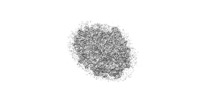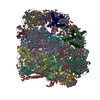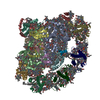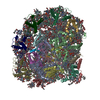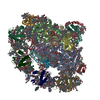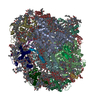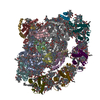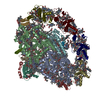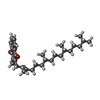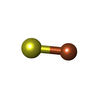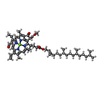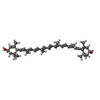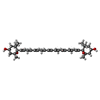+ Open data
Open data
- Basic information
Basic information
| Entry | Database: EMDB / ID: EMD-0821 | |||||||||
|---|---|---|---|---|---|---|---|---|---|---|
| Title | PSI-LHCI Supercomplex from Physcometrella patens | |||||||||
 Map data Map data | ||||||||||
 Sample Sample |
| |||||||||
| Function / homology |  Function and homology information Function and homology information photosystem I antenna complex / response to low light intensity stimulus / photosystem I antenna complex / response to low light intensity stimulus /  pigment binding / response to high light intensity / pigment binding / response to high light intensity /  photosynthesis, light harvesting in photosystem I / photosynthesis, light harvesting in photosystem I /  photosynthesis, light harvesting / photosynthesis, light harvesting /  photosystem I reaction center / photosystem I reaction center /  photosystem I / photosynthetic electron transport in photosystem I / : ... photosystem I / photosynthetic electron transport in photosystem I / : ... photosystem I antenna complex / response to low light intensity stimulus / photosystem I antenna complex / response to low light intensity stimulus /  pigment binding / response to high light intensity / pigment binding / response to high light intensity /  photosynthesis, light harvesting in photosystem I / photosynthesis, light harvesting in photosystem I /  photosynthesis, light harvesting / photosynthesis, light harvesting /  photosystem I reaction center / photosystem I reaction center /  photosystem I / photosynthetic electron transport in photosystem I / : / photosystem I / photosynthetic electron transport in photosystem I / : /  photosystem I / photosystem I /  photosystem II / photosystem II /  chlorophyll binding / chloroplast thylakoid membrane / response to light stimulus / chlorophyll binding / chloroplast thylakoid membrane / response to light stimulus /  photosynthesis / response to cold / 4 iron, 4 sulfur cluster binding / photosynthesis / response to cold / 4 iron, 4 sulfur cluster binding /  electron transfer activity / membrane => GO:0016020 / serine-type endopeptidase activity / magnesium ion binding / protein homodimerization activity / electron transfer activity / membrane => GO:0016020 / serine-type endopeptidase activity / magnesium ion binding / protein homodimerization activity /  metal ion binding metal ion bindingSimilarity search - Function | |||||||||
| Biological species |   Physcomitrella patens (plant) / Physcomitrella patens (plant) /   Moss (plant) Moss (plant) | |||||||||
| Method |  single particle reconstruction / Resolution: 3.23 Å single particle reconstruction / Resolution: 3.23 Å | |||||||||
 Authors Authors | Zhao L / Yan QJ / Qin XC | |||||||||
 Citation Citation |  Journal: Cell Discov / Year: 2021 Journal: Cell Discov / Year: 2021Title: Antenna arrangement and energy-transfer pathways of PSI-LHCI from the moss Physcomitrella patens. Authors: Qiujing Yan / Liang Zhao / Wenda Wang / Xiong Pi / Guangye Han / Jie Wang / Lingpeng Cheng / Yi-Kun He / Tingyun Kuang / Xiaochun Qin / Sen-Fang Sui / Jian-Ren Shen /   Abstract: Plants harvest light energy utilized for photosynthesis by light-harvesting complex I and II (LHCI and LHCII) surrounding photosystem I and II (PSI and PSII), respectively. During the evolution of ...Plants harvest light energy utilized for photosynthesis by light-harvesting complex I and II (LHCI and LHCII) surrounding photosystem I and II (PSI and PSII), respectively. During the evolution of green plants, moss is at an evolutionarily intermediate position from aquatic photosynthetic organisms to land plants, being the first photosynthetic organisms that landed. Here, we report the structure of the PSI-LHCI supercomplex from the moss Physcomitrella patens (Pp) at 3.23 Å resolution solved by cryo-electron microscopy. Our structure revealed that four Lhca subunits are associated with the PSI core in an order of Lhca1-Lhca5-Lhca2-Lhca3. This number is much decreased from 8 to 10, the number of subunits in most green algal PSI-LHCI, but the same as those of land plants. Although Pp PSI-LHCI has a similar structure as PSI-LHCI of land plants, it has Lhca5, instead of Lhca4, in the second position of Lhca, and several differences were found in the arrangement of chlorophylls among green algal, moss, and land plant PSI-LHCI. One chlorophyll, PsaF-Chl 305, which is found in the moss PSI-LHCI, is located at the gap region between the two middle Lhca subunits and the PSI core, and therefore may make the excitation energy transfer from LHCI to the core more efficient than that of land plants. On the other hand, energy-transfer paths at the two side Lhca subunits are relatively conserved. These results provide a structural basis for unravelling the mechanisms of light-energy harvesting and transfer in the moss PSI-LHCI, as well as important clues on the changes of PSI-LHCI after landing. | |||||||||
| History |
|
- Structure visualization
Structure visualization
| Movie |
 Movie viewer Movie viewer |
|---|---|
| Structure viewer | EM map:  SurfView SurfView Molmil Molmil Jmol/JSmol Jmol/JSmol |
| Supplemental images |
- Downloads & links
Downloads & links
-EMDB archive
| Map data |  emd_0821.map.gz emd_0821.map.gz | 202.1 MB |  EMDB map data format EMDB map data format | |
|---|---|---|---|---|
| Header (meta data) |  emd-0821-v30.xml emd-0821-v30.xml emd-0821.xml emd-0821.xml | 25.9 KB 25.9 KB | Display Display |  EMDB header EMDB header |
| FSC (resolution estimation) |  emd_0821_fsc.xml emd_0821_fsc.xml | 13.6 KB | Display |  FSC data file FSC data file |
| Images |  emd_0821.png emd_0821.png | 48 KB | ||
| Archive directory |  http://ftp.pdbj.org/pub/emdb/structures/EMD-0821 http://ftp.pdbj.org/pub/emdb/structures/EMD-0821 ftp://ftp.pdbj.org/pub/emdb/structures/EMD-0821 ftp://ftp.pdbj.org/pub/emdb/structures/EMD-0821 | HTTPS FTP |
-Related structure data
| Related structure data |  6l35MC M: atomic model generated by this map C: citing same article ( |
|---|---|
| Similar structure data |
- Links
Links
| EMDB pages |  EMDB (EBI/PDBe) / EMDB (EBI/PDBe) /  EMDataResource EMDataResource |
|---|---|
| Related items in Molecule of the Month |
- Map
Map
| File |  Download / File: emd_0821.map.gz / Format: CCP4 / Size: 216 MB / Type: IMAGE STORED AS FLOATING POINT NUMBER (4 BYTES) Download / File: emd_0821.map.gz / Format: CCP4 / Size: 216 MB / Type: IMAGE STORED AS FLOATING POINT NUMBER (4 BYTES) | ||||||||||||||||||||||||||||||||||||||||||||||||||||||||||||
|---|---|---|---|---|---|---|---|---|---|---|---|---|---|---|---|---|---|---|---|---|---|---|---|---|---|---|---|---|---|---|---|---|---|---|---|---|---|---|---|---|---|---|---|---|---|---|---|---|---|---|---|---|---|---|---|---|---|---|---|---|---|
| Voxel size | X=Y=Z: 1.061 Å | ||||||||||||||||||||||||||||||||||||||||||||||||||||||||||||
| Density |
| ||||||||||||||||||||||||||||||||||||||||||||||||||||||||||||
| Symmetry | Space group: 1 | ||||||||||||||||||||||||||||||||||||||||||||||||||||||||||||
| Details | EMDB XML:
CCP4 map header:
| ||||||||||||||||||||||||||||||||||||||||||||||||||||||||||||
-Supplemental data
- Sample components
Sample components
+Entire : PSI-LHCI
+Supramolecule #1: PSI-LHCI
+Macromolecule #1: Photosystem I P700 chlorophyll a apoprotein A1
+Macromolecule #2: Photosystem I P700 chlorophyll a apoprotein A2
+Macromolecule #3: Photosystem I iron-sulfur center
+Macromolecule #4: Predicted protein PsaD
+Macromolecule #5: PsaE
+Macromolecule #6: PSI-F
+Macromolecule #7: Predicted protein PsaG
+Macromolecule #8: PsaH photosystem I reaction center subunit
+Macromolecule #9: Photosystem I reaction center subunit VIII
+Macromolecule #10: Photosystem I reaction center subunit IX
+Macromolecule #11: PsaK
+Macromolecule #12: PSI subunit V
+Macromolecule #13: Photosystem I reaction center subunit XII
+Macromolecule #14: Chlorophyll a-b binding protein, chloroplastic
+Macromolecule #15: Chlorophyll a-b binding protein, chloroplastic
+Macromolecule #16: Chlorophyll a-b binding protein, chloroplastic
+Macromolecule #17: Chlorophyll a-b binding protein, chloroplastic
+Macromolecule #18: CHLOROPHYLL A
+Macromolecule #19: PHYLLOQUINONE
+Macromolecule #20: 1,2-DIPALMITOYL-PHOSPHATIDYL-GLYCEROLE
+Macromolecule #21: BETA-CAROTENE
+Macromolecule #22: IRON/SULFUR CLUSTER
+Macromolecule #23: DIGALACTOSYL DIACYL GLYCEROL (DGDG)
+Macromolecule #24: 1,2-DISTEAROYL-MONOGALACTOSYL-DIGLYCERIDE
+Macromolecule #25: CHLOROPHYLL B
+Macromolecule #26: (3R,3'R,6S)-4,5-DIDEHYDRO-5,6-DIHYDRO-BETA,BETA-CAROTENE-3,3'-DIOL
+Macromolecule #27: (3S,5R,6S,3'S,5'R,6'S)-5,6,5',6'-DIEPOXY-5,6,5',6'- TETRAHYDRO-BE...
-Experimental details
-Structure determination
 Processing Processing |  single particle reconstruction single particle reconstruction |
|---|---|
| Aggregation state | particle |
- Sample preparation
Sample preparation
| Buffer | pH: 7.4 |
|---|
- Electron microscopy
Electron microscopy
| Microscope | FEI TITAN KRIOS |
|---|---|
| Electron beam | Acceleration voltage: 300 kV / Electron source:  FIELD EMISSION GUN FIELD EMISSION GUN |
| Electron optics | Illumination mode: FLOOD BEAM / Imaging mode: BRIGHT FIELD Bright-field microscopy Bright-field microscopy |
| Image recording | Film or detector model: GATAN K2 SUMMIT (4k x 4k) / Average electron dose: 50.0 e/Å2 |
| Experimental equipment |  Model: Titan Krios / Image courtesy: FEI Company |
 Movie
Movie Controller
Controller



